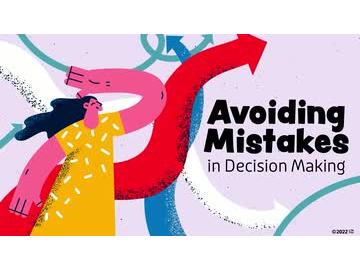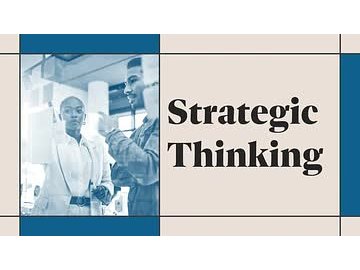Avoiding Mistakes in Decision Making
If you've ever made a bad business decision, it can haunt you forever. Whether it was financially detrimental, ethically unwise, or just a bad choice with a negative outcome, you're left to pick up the pieces and start over. You can avoid making these mistakes in decision making by remembering your ABCs: active, balanced, and conscientious. In this program, we'll talk about how to be all three of these things, in order to avoid making crucial decision-making mistakes.
Working with a group to make tough decisions can be tremendously beneficial. Having more people involved means harnessing the creative power of multiple minds, which can result in innovative and out-of-the-box solutions. These advantages can be eclipsed, however, if thoughtful decision-making processes aren't in place. Strong personalities may dominate the discussion and crush ideas put forth by others. Or a group could struggle with coming to any sort of conclusion at all. So, how do you achieve good results when making group decisions? In this course, we'll talk about how to use the strength in numbers approach in order to make decisions. We'll go over how to get organized and talk through the group decision-making process.
Empowering Employee Decisions
Empowering employees to make decisions is becoming more common in the workplace, especially with the increase in remote workers. When employees are empowered to make choices, they gain confidence, feeling more invested in their work and the success of the company. Their work progresses more efficiently, without the need to continually stop and wait for approval. It puts a stop to the "I've got to check with my supervisor" conversations, which cause annoyance and dissatisfaction with customers. In this course, we'll talk about how to empower your employees. We'll talk about setting clear boundaries and giving your team the information they need to become more empowered. We'll also go over how to support empowered decision making.
We often hear stories of leaders in battle or in business going with their gut to make quick decisions. How many times in your personal life have you been told to trust your instincts? And yet, in business education we're usually taught to rely on data or evidence, so we can base our decisions on facts and analysis. So, should you go with your gut or not? We'll answer that question, and more, in this program. We'll go over what it means to use your intuition to make a decision. We'll also discuss how to develop and hear your intuition.
Identifying Unintended Consequences
When we make decisions in business, our actions have intended consequences. But they also have unintended consequences. In other words, we decide to do something for a particular outcome, but many times there are other outcomes that we don't anticipate or expect. So how do we identify and understand unintended consequences of our decisions? In this course, we'll discuss a theory by American sociologist, Robert K. Merton and talk about what causes unintended consequences. We'll also go over the various types and learn how to identify possible unintended consequences.
Strategic thinking is about more than solving the problem in front of you - it's about understanding the big picture and planning for what's next. Developing this mindset can help you identify opportunities, navigate uncertainty, and guide your organization toward long-term success. Here, you'll learn how to ask the right questions, challenge assumptions, and build strategies that align with your goals and purpose.
What happens if you make the wrong choice? Do you end up, shipwrecked, and abandoned on The Island of Bad Decisions? How do you survive it? This course is your life raft of answers! It sails you through three steps of recovery, from acknowledgment to corrective action, then to the safe haven of "moving forward."
Decision Making Basics: Gathering Information
We are constantly making choices. Where to turn, what to eat, which work to start on, what to say on a call, etc. Of course, we always want to make informed choices, and living in the information age, finding information is easier than ever before. The trick is knowing where to find the data you need, and how to determine what sources are trustworthy and reliable. In this course, we'll talk about how to properly gather information to make good, informed decisions. We'll go over the difference between data and knowledge, the various sources of data, and how to know when to stop gathering it.
Decision Making Basics: Understanding Motivation
Motivation is defined as the activation of goal-pursuing behavior. Motivation is the drive that pushes people to get things done. Over the years, much research has been conducted to find out what gets people motivated, and what helps them stay that way. To maximize workplace motivation, an employer must remove causes of dissatisfaction AND provide opportunities for satisfaction. In this course, we'll look at what truly drives people by discussing two types of motivation. We'll also walk viewers through hidden motivators, also known as cognitive biases, which tend to run in the background, yet still greatly impact decision making.
Decision Making Basics: Making Quick Decisions
Have you ever been in a situation where you know you must make a decision, but you're dreading it? Making up your mind is so painful that you've been postponing the inevitable? Or, you've made a decision after careful thought, but then second-guess yourself, and pick apart your thought process and rationale? If either of these scenarios sound familiar, then you're probably one of the multitudes of people who have trouble making decisions quickly. This can be detrimental to your company or career, if you have difficulty deciding. So, in this course, we'll talk about overcoming roadblocks that get in the way of decision making. We'll also walk you through some good decision-making tips to help you decide on things quickly and confidently.
Decision Making Basics: Facts vs. Opinions
Opinions are a flimsy and unreliable basis for business decisions. All too often, however, people do just that: base their workplace decisions upon the shaky foundation of their own or others' opinions. When what they really should be doing is basing their decisions on facts. Many struggle with even knowing if what they're hearing is a fact or an opinion. In this program, we'll talk about the difference between the two, and go over the various types of facts and opinions. We'll discuss how to use both in your decision making, and teach you how to test yourself, so you know that what you're basing your decision on is factual.
Decision Making Basics: Generating Options
"I had no choice." "I wish there was another way to go..." "I'm stuck between a rock and a hard place." No matter how you say it, the desire for more choices is a common one. A lot of the time, the hardest thing about making a decision is producing options in the first place. When you find yourself struggling to find viable options, or any options, two simple steps can help you move beyond the obvious and find creative solutions: naming the box and brainstorming. That's what we'll cover in this course on generating options.
Decision Making Basics: Decision-Making Models
Over the last few decades, experts have studied and analyzed how decisions are successfully made. These models provide a framework for the decision-making process. In this program, we'll give you a brief introduction to two of these models and go over when we recommend utilizing them. When making quick decisions, we recommend using the TDODAR decision model. And for decisions that require deep analysis, we recommend using the Kepner-Tregoe matrix. Keep in mind, these models are adaptable and not set in stone. They can be used in different scenarios than traditionally recommended.
Decision Making Basics: Decision-Making Styles
When different people make decisions, they approach those decisions in different ways. In other words, they have different styles of decision making. In fact, there are generally four recognized styles of decision making. They are directive, analytical, conceptual, and behavioral. In this program, we'll go over how to identify the different styles, and share the positives and negatives of each.
















